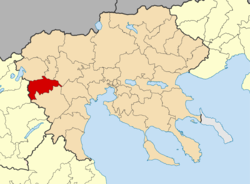Naoussa (Imathia)
|
Naoussa municipality Δήμος Νάουσας (Νάουσα) |
||
|---|---|---|
|
|
||
| Basic data | ||
| State : |
|
|
| Region : | Central Macedonia | |
| Regional District : | Imathia | |
| Geographic coordinates : | 40 ° 38 ′ N , 22 ° 4 ′ E | |
| Area : | 424.91 km² | |
| Residents : | 32,494 (2011) | |
| Population density : | 76.5 inhabitants / km² | |
| Post Code: | 59200 | |
| Prefix: | (+30) 23320 | |
| Community logo: | ||
| Seat: | Naoussa | |
| LAU-1 code no .: | 0803 | |
| Districts : | 3 municipal districts | |
| Local self-government : | 14 local communities | |
| Website: | www.naousa.gr | |
| Location in the Central Macedonia region | ||
Naoussa ( Greek Νάουσα Naousa ( f. Sg. ), Pronounced Náusa; Macedonian Negusch Негуш; older names Niausta, Niagusta, Agoston and Agustos ) is a city with almost 20,000 inhabitants in the northern Greek region of Central Macedonia .
At the same time, Naoussa has been a municipality (dimos) since 1918 , which was constantly enlarged by incorporations through the two Greek administrative reforms in 1997 and 2010, most recently in 2010 by the incorporation of the neighboring municipalities of Anthemia and Irinoupoli .
Geography and history
The municipality of Naousa is located on the western edge of the Central Macedonian Plain, which is formed by the rivers (from south to north or east) Aliakmonas, Loudias, Axios and Gallikos. Parts of the municipality lie on the northern regions of the Vermio Mountains, rising west of the small town , which represent the western boundary of the Central Macedonian lowlands; other parts of the community are in the lowlands themselves or in the transition from the vermio to the lowlands. The next larger city or municipality in the north is Edessa and in the south Veria , the capital of the prefecture of Imathia.
After its conquest in the late 14th century, Naoussa was part of the Ottoman Empire until the first Balkan War . On November 1, 1912, the Ottoman administration was driven out of Naoussa and subsequently the city was occupied by the Greek troops advancing from the south (Veria). Afterwards Naoussa was de facto part of the Greek state (kingdom), which was finally confirmed with the peace of Bucharest in 1913.
Naousa was the scene of a heavy battle between the Greek rebels and the Ottoman occupation forces in the Greek War of Independence (1821-1829) in 1821 . The latter remained victorious despite considerable opposition. A memorial in Naoussa now commemorates the Greek victims of these battles.
Also in the Greek Civil War (1946-1949) Naoussa was the scene of armed clashes between the communist-controlled insurgents and the regular Greek army under the control of the right-wing central government in Athens. On August 10, 1947, the city was attacked by 500 insurgents and temporarily occupied, but had to be evacuated again afterwards. 200 houses were destroyed by fire in the fighting, including a church.
The economic mainstay of the city or municipality is agriculture and especially the cultivation of wine . Both the Naoussa wine-growing region and the popular red grape variety Mavro Naoussis have been named after the town. The Wine and Vine Museum is located here.
A monastery was consecrated in this place on June 16, 1978, in which the Pontic Greek monks of the Kuştul monastery of Maçka near Trabzon are buried.
| year | Residents | Residents in the parish |
|---|---|---|
| 1981 | 19,430 | - |
| 1991 | 19,794 | 22,637 |
| 2001 | - | 22,274 |
Town twinning
Naoussa is twinned with the following cities:
- Asenovgrad , Bulgaria
- Zgorzelec , Poland
sons and daughters of the town
- Sophia Ralli (* 1988), ski racer
photos
See also
Individual evidence
- ↑ Results of the 2011 census. ( Memento from June 27, 2015 in the Internet Archive ) ( MS Excel ; 2.6 MB) National Statistical Service of Greece (ΕΛ.ΣΤΑΤ)
- ↑ Newspaper article in the Greek newspaper Embros , October 20, 1912, p. 4, right column
- ^ Friedrich Immanuel: The Balkan War 1912/13. Issue 2/3: The war up to the beginning of the armistice in December 1912. Verlag Ernst Siegfried Mittler and Son, Berlin 1913, p. 91.
- ↑ Newspaper article in the Greek newspaper Eleftheria , August 20, 1947, p. 4, left column.
- ^ Town twinning of Asenovgrad (Bulgarian)





